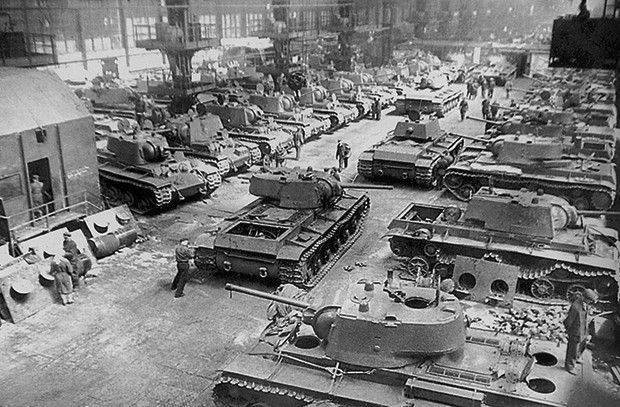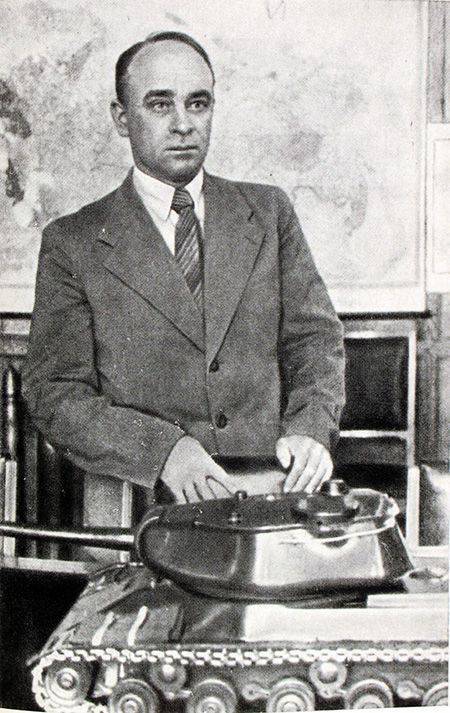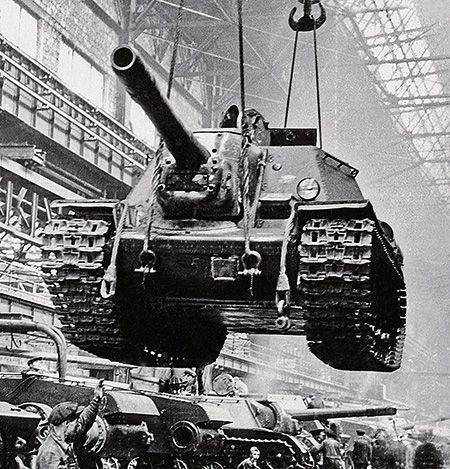“The machine is our weapon”

How Chelyabinsk became a Tankograd during the Great Patriotic War
Chelyabinsk Tractor Plant was the main production center tanks in the country. It was here that the legendary BM-13 - Katyusha installations were produced. Every third tank, combat aircraft, cartridge, mine, bomb, landmine and rocket were made of Chelyabinsk steel.
From “Klim Voroshilov” to “Joseph Stalin”
The first tank at the Chelyabinsk Tractor Plant (CTZ) was assembled at the end of 1940 of the year. For the past six months, only 25 machines of the experimental model KV-1 were produced, the name of which was decoded as “Klim Voroshilov”.
In the pre-war years, the main production of tanks in Soviet Russia was concentrated on two enterprises - the Kirov plant in Leningrad (now St. Petersburg - Prim.red.) And the Kharkov engine building. Almost immediately after the outbreak of hostilities, the production was in the reach of the fascist aviation. Then they were evacuated to Chelyabinsk and combined with ChTZ, which as a result became the main center of defense tank construction and received the temporary name - Chelyabinsk Kirov Plant. So Tankograd appeared.
“The status of the All-Russian Center of the Tank Industry for Chelyabinsk was entrenched with the creation in the city of the People’s Commissariat of the Tank Industry,” historian Sergey Spitsyn tells the RP. - He was headed by Vyacheslav Alexandrovich Malyshev, who, jokingly and with Stalin’s tacit consent, was called the “Prince of Tankograd”. This talented designer enjoyed the special location of the Generalissimo. ChTZ became the director of Isaac Zaltsman, whom the allies called the "King of Tanks." Under the "princely" and "royal" leadership at ChTZ, during the war years, 13 released new models of tanks and self-propelled guns, a total of 18 thousand combat vehicles. Every fifth tank, made in the country, went to beat the enemy from the shops of the Ural enterprise.
In 1942, for the first time, CTZ sent the legendary T-34 to the front. Their mass production was adjusted in just 33 of the day, although before that it was believed that the serial production of combat vehicles of this class could not be started faster than in four to five months. For the first time in world practice, they put on the conveyor and manufacture of a heavy tank. The on-line assembly began on 22 August 1942 of the year, and by the end of 1943, the plant had been producing X-NUMX T-25 machines and 34 heavy tanks on a daily basis.
“Dozens of volumes have been written about the role that T-34 played in the Great Patriotic War,” says military historian Leonid Marchevsky. - It was this tank that received the tender nickname “Swallow” on the front and brought victory in the defense of Moscow, Stalingrad and the Battle of Kursk. T-34 has become a legend, one of the symbols of the victorious Red Army. This is the only tank that is not obsolete in all the war years, when the development of weapons went faster than ever, and is still used in some third world countries. That is why this tank is most often installed on pedestals as a monument to the Great Victory. Most of the monumental tanks are in good condition, even though now in battle again.
Hunting for "Tigers"
By the end of 1942, the Nazis found a way to resist the T-34, sent into battle a new weapon - heavy "Tigers". Powerful armor and enhanced weapons made these tanks virtually invulnerable to Soviet combat vehicles. Therefore, before the factory designers have set a new task - in the shortest possible time to create and launch into production a tank that can hunt the "Tigers". The order was issued in February 1943 of the year, and in September, the first heavy tank of the IS series was released at ChTZ, which was decoded as "Joseph Stalin".

“It was a real victory weapon, a steel fortress!” - admires Leonid Marchevsky. - EC-2 was originally designed to conduct offensive operations, could effectively attack the most powerful defensive fortifications. This tank was no less maneuverable than the T-34, but it had significantly heavier weapons and armor. His 122 mm gun could break any resistance. The fascists quickly became convinced of the unsurpassed at that time firepower of the new Soviet tank and gave an unspoken order at all costs to avoid entering into open battle with the EC-2. With the advent of this machine, the USSR won the “war of armor”, as the opposition of the Russian and German designers was then called. Tanks similar to the EC-2 were not available at that time in any army in the world. Only Chelyabinsk, Isam was able to demolish a powerful line of defense when the Red Army launched an offensive against Germany.
After the Battle of Kursk, the Soviet command gave the order to slightly modify the model, making the tower more streamlined. This is how the EC-3 appeared, which rolled off the assembly line in 1945, and managed to take part only in the Victory Parade. However, this tank was in service with the army of the USSR until the beginning of the 90-s of the last century.
In January, 1943, the factory collected the first sample of the SU-152 - the legendary self-propelled gun, which received the nickname "St. John's Wort" on the front. So the war machine was nicknamed for the fact that its 152-millimeter howitzer cannon, firing 50-kilogram shells, easily penetrated the armor of the fascist Tigers and Panthers. The appearance of the SU-152 at the Kursk Bulge largely decided the outcome of the battle, becoming a complete surprise for the Nazis. Until the end of the war, CTZ sent more than 5 thousand installations to the front.
Women, children and old people
Because every day new tanks and self-propelled guns were sent to the front to smash the enemy, Tankograd had to pay a high price. Workers four years of war worked hard.
“The first difficult task that they had to solve was to accept and place the equipment that came from the Leningrad and Kharkov factories,” says Sergey Spitsyn. “The equipment was sorely lacking, so the heavy machines were unloaded from the cars and pulled to the place by hand, on special drags. There they were installed in wastelands and launched directly "from the wheels." Worked in the open air, not paying attention to the weather. In the autumn it is still tolerable, but in winter it became completely unbearable. So that people could at least touch the ice armor, they built bonfires under the collected tanks. Only when it became clear that the workers would simply freeze over, they began to build a roof over such improvised workshops, and then walls.
Another problem was that most workers did not have the appropriate qualifications and needed to be trained from scratch. Most skilled mechanics, turners, grinders are gone to beat the enemy. Their place was taken by retirees, women and teenagers 16 – 14 years. Young men were more necessary at the front.
Before the war, 15, thousand people worked at ChTZ, and by the year 1944, there were already thousands of 44. 67% of workers, getting up to the machine for the first time, had no idea what and how they were to do. All of them needed to be trained from scratch, and on the job, because their help was needed right here and now, there was no time to wait.
"Machines broke, and we kept"
Already in the first days of the war, the shift at ChTZ was increased from 8 to 11 hours. And when the fascists approached Moscow, and the situation became critical, all the workers of the plant went over to the barracks. In the old workshops that were barely heated by three locomotive boilers and new, generally unheated new ones, and sometimes even in the open air, they worked on 18 or even 20 hours per day. For the change performed two or three rules. How many more people will be able to withstand work in inhuman conditions, no one thought. The slogan “Everything for the front, everything for victory!” Was perceived literally at ChTZ, and they sacrificed their health and lives.
“The first day off in the four years of the war for us was 9 May 1945 of the year,” veteran ChTZ Ivan Grabar, who worked at the plant since 1942, tells the RP. - At ChTZ, I ended up in 17 for years, after being evacuated from the Stalingrad Tractor Plant. The first month he lived in the personnel department, slept right on the floor. When settling, I was “assigned” to one Chelyabinsk house, where, as it was believed, there were still empty seats, but there no less than 20 people lived in one tiny room. Then I decided not to embarrass them and settled down right in the factory. So many did. Therefore, over time, we were resettled in the shops, installing bunk beds next to the machines. Then there was the norm: for one person - 2 square meters of space. Cramped, of course, but convenient. There wasn’t any sense to leave the factory home anyway, there was only three or four hours to sleep, there wasn’t the slightest desire to spend them on the road. True, in the workshop in the winter it was never warmer than 10 degrees, so we were constantly freezing. Yes, and the air was stale. But nothing suffered, there was no time to hurt. Machines broke, and we kept.
Once every two weeks, workers were given time to wash and wash their clothes. And then - again to the machine. With such an inhuman schedule, the workers who worked throughout the war for at least 18 hours a day were fed so poorly that the feeling of satiety never occurred.
- The first shift began at 8 in the morning. There was no breakfast in principle, ”Ivan Grabar recalls. - At two o'clock in the afternoon it was possible to have lunch in the dining room. There, at first, they gave us lentil soup, about which we joked that in it “a grain of grain chasing a baton”. Periodically, it came across potatoes. On the second, a camel, horsemeat or saiga meat cutlet with some side dish. While I was waiting for the second, I usually could not stand it and ate all the bread I had gotten - I wanted to eat intolerably constantly. We had dinner at 12 at night: a can of American stew was washed down with one hundred grams of the front. They were needed to fall asleep and not freeze. The first time we drank properly, 9 may 1945 of the year. When heard news about victory, they threw off a brigade and bought a bucket of wine at all. Noted Sang songs, danced.
Many workers came to the factory as children, and therefore the older ones, who were themselves 17 – 18 years old, were looking after them. They took their ration cards, issued for the whole month, and then gave them one per day. Otherwise, the children could not stand it and ate the entire monthly supply at once, at a time, risking to die of starvation. They made sure that small turners and locksmiths did not fall from the boxes, which were put in order to reach the machine. And also, so as not to fall asleep right at the workplace and not to fall on the machine, where certain death was waiting for them. Similar cases were also.

Alexander Frolov, 16-year-old, who was evacuated from Leningrad and became a brigadier at the CTZ, followed the younger generation. She had 15 teenage girls in submission.
- Worked for days. When the hands froze to the machines, they hardly tore them off, warmed them in a barrel of water so that their fingers bend, and again get up to work. I don't know where our strength came from. They also had time to think about “beauty” - right in the workshop, without leaving the machine, they washed their heads with cold soap emulsion, - she recalls.
"Black knives"
“The most interesting thing is that already in 1942, these adolescents, who recently had not the slightest idea of production, exhausted from constant hunger and overwork, learned to perform several norms a day,” Nadezhda Dida, director of the Museum of Labor and Military Glory, told the RP. ChTZ. - So, in April, turner Zina Danilova exceeded the norm by 1340%. Not only the Stakhanov movement became the norm, but also the multi-machine movement, when one worker served several machines. Brigades fought for the honorary title of "frontline". The first was the team of milling workers Anna Pashina, in which 20 girls performed the work of 50-ti skilled workers of the pre-war period. Each of them served on two or three machines. Her initiative was picked up by a brigade of Alexander Salamatov, who said: "We will not leave the shop until we have completed the task." Then - Vasily Gusev, who put forward the slogan: “My machine is a weapon, the area is a battlefield.” So, you do not have the right to leave the machine without completing the task of the front.
I had to recruit and train new workers. The boys, fezushniki, not having managed to grow up, dreamed not only to send tanks to the front, but to go along with them to beat the fascists. When such a chance appeared, he was not missed. At the beginning of 1943, the Chelyabinsk workers raised money and bought 60 tanks from the state, forming the 244-second tank brigade. Volunteers have applied for enrollment of more than 50 thousand applications. 24 thousands of citizens lined up to get to the front. Of them, the entire 1023 of the person was selected, mainly the workers of the CTZ - they knew better than most of the tankmen how to deal with tanks, since they made them with their own hands.
“The Fascists called this brigade Black Knives, because for each of the Chelyabinsk fighters, the Chrysostom gunsmiths forged a short blade with black handles and handed them as a gift before being sent to the front,” says Sergey Spitsin. - During the largest in stories tank battle - the Battle of Kursk, this brigade showed such courage that it was renamed the 63-th Guards. The “black knives” were feared by the fascists like fire, because the Chelyabinsk guys were distinguished by their special endurance and quenching. They took part in the capture of Berlin, and on May 9, 1945 released the last city in Europe, which remained at that time under the control of the Nazis - Prague. The brigade commander, Mikhail Fomichev, had the honor of accepting the symbolic keys of Prague.
The workers of ChTZ still remember the words of Hitler's propaganda minister Joseph Goebbels, said in January 1943: “It seems a miracle that new masses of people and equipment appeared from vast steppes, as if some great wizard made Bolshevik Urals clay people and equipment in any quantity. "
Information